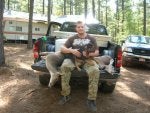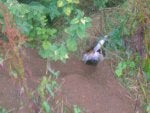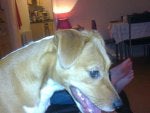Dogs noses don't work like ours. They can separate out the individual odors. The hide is sure to have blood on it so it's plausible that the dog can differentiate the two deer based on that, but if you lay only a blood track with no hide drag and lay the hide at the end I'm certain he won't mind. You could, I guess, rub some of the blood on the hide.
As for crossing the track of another deer; the dog can tell. Now I'm not saying that he won't lose focus and switch tracks if the new one is fresher, but if he does it's most likely due to youth or inexperience. You could train for this by laying a track with one hide and crossing it somewhere with another. By keeping him on a check cord you can correct him if he does switch, but that's just not a problem I've seen.
I also have beagles that I run rabbits with and the area I run them has an abundance of both deer and rabbits. I've never had a problem with them switching tracks. It's also amazing and very educational to watch them. Rabbits are notorious for making a track as complicated as possible, especially when they get run repeatedly. I've seen them turn around and backtrack quite a ways and then seen the dogs come along on the track and pick up that the rabbit has backtracked before they ever reach his turnaround point. The only way this is possible is by strength of the scent and it's amazing that they can pick up on this. Same with direction of travel. If I jump a rabbit instead of the dogs jumping him and I call them over midtrack they will ALWAYS take off in the direction the rabbit ran. To be able to figure this out within minutes at most of the track being laid down tells me the scent is telling them.
I've gone off on a tangent here, lol, but think of a dogs nose like this; if you walk into the kitchen with a pot of deer stew on you will say, "deer stew!". When the dog walks in the kitchen he will think, "deer, barley, peas, carrots, taters, celery, salt, pepper, garlic".....he smells in layers.






























